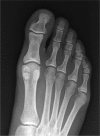Turf toe: A clinical update
- PMID: 30305934
- PMCID: PMC6174855
- DOI: 10.1302/2058-5241.3.180012
Turf toe: A clinical update
Abstract
Turf toe is a condition that describes injury to the plantar metatarsophalangeal-sesamoid complex of the great toe.It is a relatively rare and debilitating condition, particularly seen in American footballers after the introduction of harder, artificial 'turf' surfaces.Turf toe represents a significant injury to the hallux and requires a high index of suspicion.If unrecognized, it can lead to chronic problems including reduced push-off strength, persistent pain, progressive deformity and eventual joint degeneration.Patients with chronic injuries may have worse outcomes, and therefore early, accurate diagnosis and initiation of treatment play a vital role.A multidisciplinary team approach is key for successful return to sport. Cite this article: EFORT Open Rev 2018;3:501-506. DOI: 10.1302/2058-5241.3.180012.
Keywords: football; hallux; plantar plate; push off; rehabilitation; rugby; sesamoid.
Conflict of interest statement
ICMJE Conflict of interest statement: None declared.
Figures




References
-
- Bowers KD, Martin RB. Turf-toe: a shoe-surface related football injury. Med Sci Sports 1976;8:81-83. - PubMed
-
- George E, Harris HS, Dragoo JL, Hunt KJ. Incidence and risk factors for turf toe injuries in intercollegiate football: data from the National Collegiate Athletic Association Injury Surveillance System. Foot Ankle Int 2013;35:108-115. - PubMed
-
- Rodeo SA, O’Brien SJ, Warren RF, Barnes R, Wickiewicz TL. Turf toe: diagnosis and treatment. Phys Sportsmed 1989;17:132-147. - PubMed
-
- Clanton TO, Ford JJ. Turf toe injury. Clin Sports Med 1994;13:731-741. - PubMed
-
- McCormick JJ, Anderson RB. The great toe: failed turf toe, chronic turf toe, and complicated sesamoid injuries. Foot Ankle Clin 2009;14:135-150. - PubMed
LinkOut - more resources
Full Text Sources

